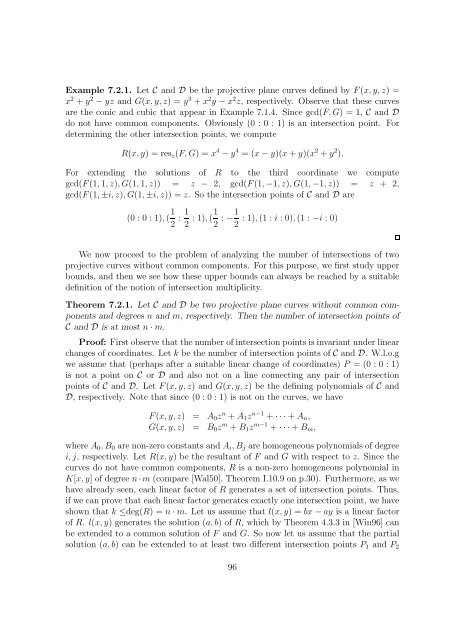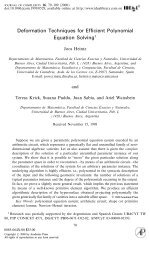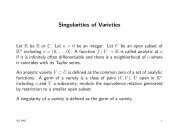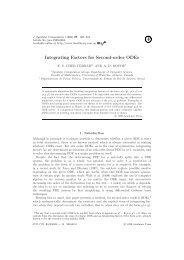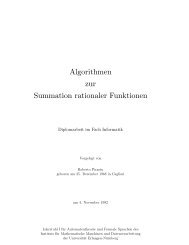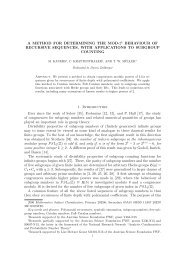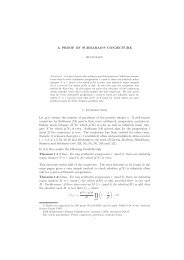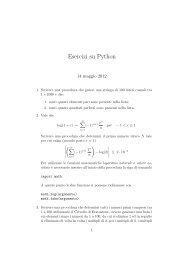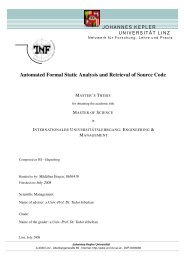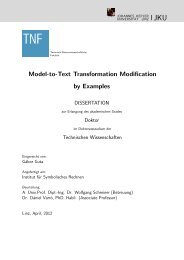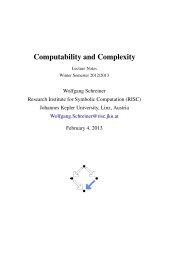Chapter 7 Local properties of plane algebraic curves - RISC
Chapter 7 Local properties of plane algebraic curves - RISC
Chapter 7 Local properties of plane algebraic curves - RISC
You also want an ePaper? Increase the reach of your titles
YUMPU automatically turns print PDFs into web optimized ePapers that Google loves.
Example 7.2.1. Let C and D be the projective <strong>plane</strong> <strong>curves</strong> defined by F(x, y, z) =<br />
x 2 + y 2 − yz and G(x, y, z) = y 3 + x 2 y − x 2 z, respectively. Observe that these <strong>curves</strong><br />
are the conic and cubic that appear in Example 7.1.4. Since gcd(F, G) = 1, C and D<br />
do not have common components. Obviously (0 : 0 : 1) is an intersection point. For<br />
determining the other intersection points, we compute<br />
R(x, y) = res z (F, G) = x 4 − y 4 = (x − y)(x + y)(x 2 + y 2 ).<br />
For extending the solutions <strong>of</strong> R to the third coordinate we compute<br />
gcd(F(1, 1, z), G(1, 1, z)) = z − 2, gcd(F(1, −1, z), G(1, −1, z)) = z + 2,<br />
gcd(F(1, ±i, z), G(1, ±i, z)) = z. So the intersection points <strong>of</strong> C and D are<br />
(0 : 0 : 1), ( 1 2 : 1 2 : 1), (1 2 : −1 2<br />
: 1), (1 : i : 0), (1 : −i : 0)<br />
We now proceed to the problem <strong>of</strong> analyzing the number <strong>of</strong> intersections <strong>of</strong> two<br />
projective <strong>curves</strong> without common components. For this purpose, we first study upper<br />
bounds, and then we see how these upper bounds can always be reached by a suitable<br />
definition <strong>of</strong> the notion <strong>of</strong> intersection multiplicity.<br />
Theorem 7.2.1. Let C and D be two projective <strong>plane</strong> <strong>curves</strong> without common components<br />
and degrees n and m, respectively. Then the number <strong>of</strong> intersection points <strong>of</strong><br />
C and D is at most n · m.<br />
Pro<strong>of</strong>: First observe that the number <strong>of</strong> intersection points is invariant under linear<br />
changes <strong>of</strong> coordinates. Let k be the number <strong>of</strong> intersection points <strong>of</strong> C and D. W.l.o.g<br />
we assume that (perhaps after a suitable linear change <strong>of</strong> coordinates) P = (0 : 0 : 1)<br />
is not a point on C or D and also not on a line connecting any pair <strong>of</strong> intersection<br />
points <strong>of</strong> C and D. Let F(x, y, z) and G(x, y, z) be the defining polynomials <strong>of</strong> C and<br />
D, respectively. Note that since (0 : 0 : 1) is not on the <strong>curves</strong>, we have<br />
F(x, y, z) = A 0 z n + A 1 z n−1 + · · · + A n ,<br />
G(x, y, z) = B 0 z m + B 1 z m−1 + · · · + B m ,<br />
where A 0 , B 0 are non-zero constants and A i , B j are homogeneous polynomials <strong>of</strong> degree<br />
i, j, respectively. Let R(x, y) be the resultant <strong>of</strong> F and G with respect to z. Since the<br />
<strong>curves</strong> do not have common components, R is a non-zero homogeneous polynomial in<br />
K[x, y] <strong>of</strong> degree n ·m (compare [Wal50], Theorem I.10.9 on p.30). Furthermore, as we<br />
have already seen, each linear factor <strong>of</strong> R generates a set <strong>of</strong> intersection points. Thus,<br />
if we can prove that each linear factor generates exactly one intersection point, we have<br />
shown that k ≤deg(R) = n · m. Let us assume that l(x, y) = bx − ay is a linear factor<br />
<strong>of</strong> R. l(x, y) generates the solution (a, b) <strong>of</strong> R, which by Theorem 4.3.3 in [Win96] can<br />
be extended to a common solution <strong>of</strong> F and G. So now let us assume that the partial<br />
solution (a, b) can be extended to at least two different intersection points P 1 and P 2<br />
96


